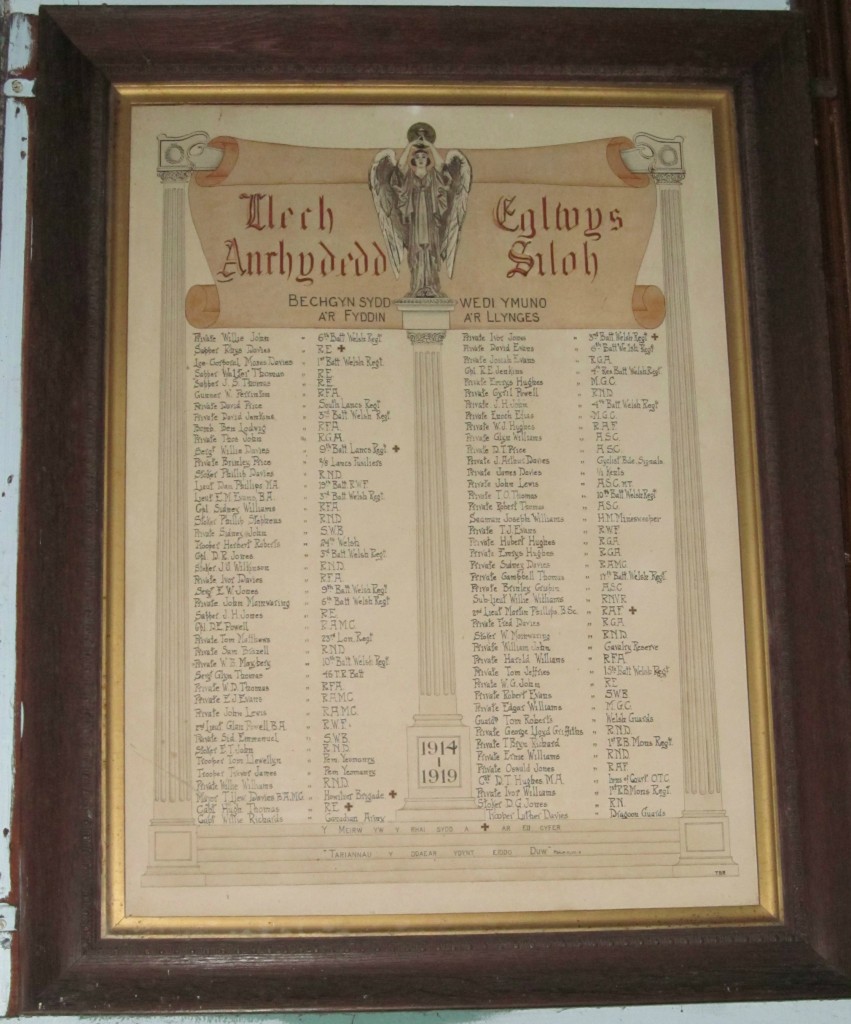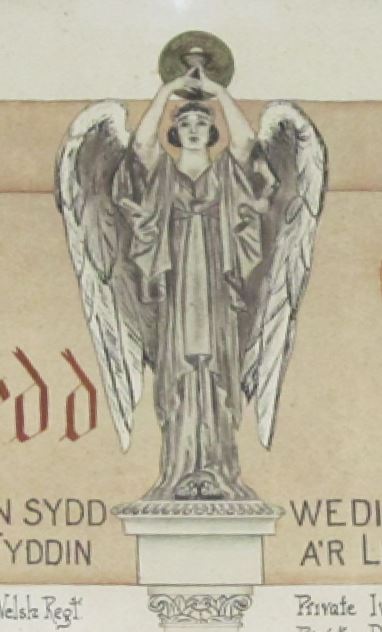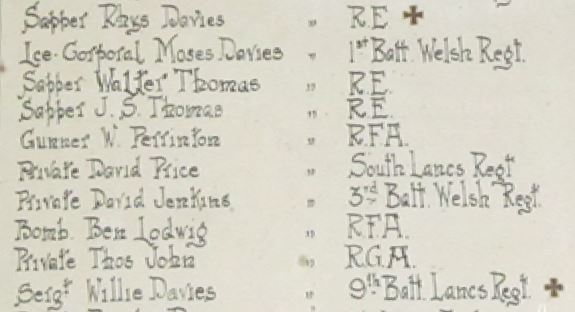The Shields of the Earth: the WW1 memorial in Siloh, Landore

After almost 190 years, the grand Independent chapel of Siloh, in the Landore area of Swansea, closed its doors in January 2016. A hundred years ago the membership stood at around 640; at the end of the Second World War, there were over 600; when the chapel closed, the number of members was in single figures.
In the building’s vestry there was a roll of honour to remember the 84 men of the chapel who served in the armed forces between 1914 and 1918. This figure is not unusal for a chapel memorial in north Swansea – there are, for example, 81 names on the memorial at Caersalem Newydd, Treboeth, and 66 on the memorial at Carmel, Morriston.
The imagery on this memorial is interesting, but again it is similar to other examples.  Classical-style pillars can be found flanking the names in the memorials of chapels such as Mynydd Bach (north Swansea), Zoar (Merthyr), Graig (Merthyr), Libanus (Dowlais) and Carmel (Aberdare), to name just five. Similarly, angels adorn the memorials in Zoar (Merthyr), and Noddfa, Abersychan.
Classical-style pillars can be found flanking the names in the memorials of chapels such as Mynydd Bach (north Swansea), Zoar (Merthyr), Graig (Merthyr), Libanus (Dowlais) and Carmel (Aberdare), to name just five. Similarly, angels adorn the memorials in Zoar (Merthyr), and Noddfa, Abersychan.
The Biblical verse (Psalm 47:9) is not one of the common choices: ‘Tariannau y ddaear ydynt eiddo Duw’ (‘the shields of the earth belong unto God’ in the King James version) although similar sentiments can be found on chapel memorials all over Wales.
While looking at the servicemen listed, we know (thanks to the chapel’s annual reports) that 18 volunteered in 1914 and 10 in 1915. Conscription was introduced in early 1916 so we cannot tell how much choice the 25 who joined up that year had, nor the 15 in 1917 nor the 12 in 1918.
 One of the men (Captain Willie Richards) served with the Canadian forces: again, there are plenty of similar examples across Wales of men who served with (in particular) the Canadian or Australian forces. This reflects the substantial emigration that had taken place from Wales to the dominions in the decade up to 1914.
One of the men (Captain Willie Richards) served with the Canadian forces: again, there are plenty of similar examples across Wales of men who served with (in particular) the Canadian or Australian forces. This reflects the substantial emigration that had taken place from Wales to the dominions in the decade up to 1914.
It is not just this ‘llech anrhydedd’ (literally ‘slate of honour’) that indicates the chapel’s viewpoint on the justice of the British cause. Letters were sent every Christmas by the minister, the Rev. Samuel Williams, to the soldiers and sailors of his flock, assuring them that Siloh supported them and prayed for them. When the men returned home on leave, the chapel organised meetings to welcome them: you can read here a report from January 1917 of a meeting when Private Tom Matthews was presented with a fountain pen by the Rev. Williams.
 Unlike many other chapel memorials, the names of those who were killed are not listed separately, nor on another memorial, but a cross was added by the names of six men to show that they died in the war.
Unlike many other chapel memorials, the names of those who were killed are not listed separately, nor on another memorial, but a cross was added by the names of six men to show that they died in the war.
Although Siloh has closed its doors as a place of worship for the last time and the building is to be sold, the future of this memorial is secure, as it has been transferred to the care of West Glamorgan Archives.
g.h.matthews April 25th, 2016
Posted In: Uncategorized